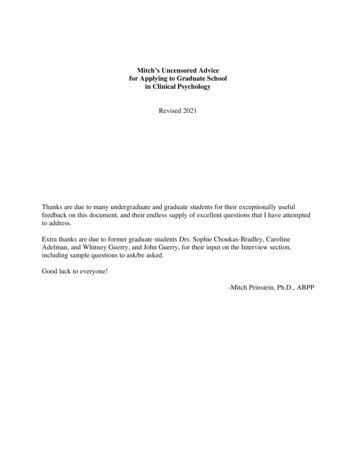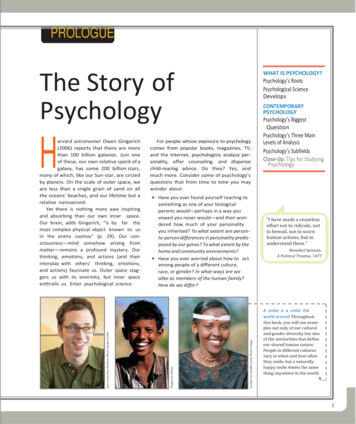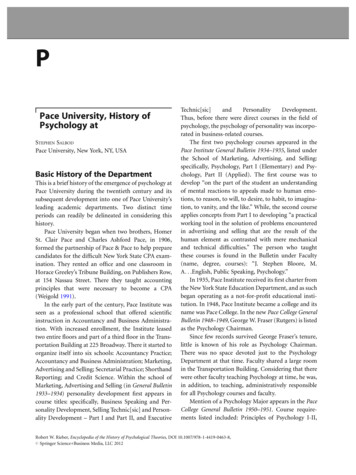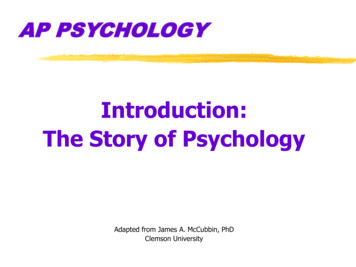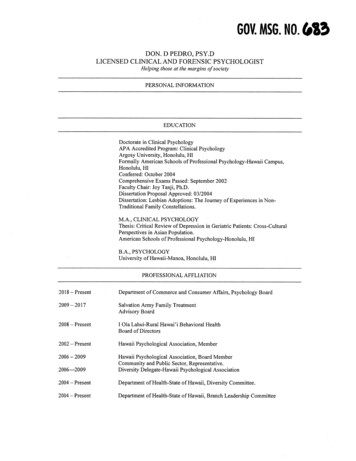
Transcription
ContemporaryClinicalPsychology
CONTEMPORARYCLINICALPSYCHOLOGYSecond EditionThomas G. PlanteSanta Clara University andStanford UniversityJOHN WILEY & SONS, INC.
➇This book is printed on acid-free paper.Copyright 2005 by John Wiley & Sons, Inc. All rights reserved.Published by John Wiley & Sons, Inc., Hoboken, New Jersey.Published simultaneously in Canada.No part of this publication may be reproduced, stored in a retrieval system, ortransmitted in any form or by any means, electronic, mechanical, photocopying,recording, scanning, or otherwise, except as permitted under Section 107 or 108of the 1976 United States Copyright Act, without either the prior writtenpermission of the Publisher, or authorization through payment of the appropriateper-copy fee to the Copyright Clearance Center, Inc., 222 Rosewood Drive,Danvers, MA 01923, (978) 750-8400, fax (978) 646-8600, or on the web atwww.copyright.com. Requests to the Publisher for permission should beaddressed to the Permissions Department, John Wiley & Sons, Inc., 111 RiverStreet, Hoboken, NJ 07030, (201) 748-6011, fax (201) 748-6008.Limit of Liability/Disclaimer of Warranty: While the publisher and author haveused their best efforts in preparing this book, they make no representations orwarranties with respect to the accuracy or completeness of the contents of thisbook and specifically disclaim any implied warranties of merchantability orfitness for a particular purpose. No warranty may be created or extended bysales representatives or written sales materials. The advice and strategiescontained herein may not be suitable for your situation. The publisher is notengaged in rendering professional services, and you should consult aprofessional where appropriate. Neither the publisher nor author shall be liablefor any loss of profit or any other commercial damages, including but notlimited to special, incidental, consequential, or other damages.This publication is designed to provide accurate and authoritative information inregard to the subject matter covered. It is sold with the understanding that thepublisher is not engaged in rendering professional services. If legal, accounting,medical, psychological or any other expert assistance is required, the services ofa competent professional person should be sought.Designations used by companies to distinguish their products are often claimedas trademarks. In all instances where John Wiley & Sons, Inc. is aware of aclaim, the product names appear in initial capital or all capital letters. Readers,however, should contact the appropriate companies for more completeinformation regarding trademarks and registration.For general information on our other products and services please contact ourCustomer Care Department within the United States at (800) 762-2974, outsidethe United States at (317) 572-3993 or fax (317) 572-4002.Wiley also publishes its books in a variety of electronic formats. Some contentthat appears in print may not be available in electronic books. For moreinformation about Wiley products, visit our web site at www.wiley.com.Library of Congress Cataloging-in-Publication Data:Plante, Thomas G.Contemporary clinical psychology / Thomas G. Plante — 2nd ed.p. cm.Includes bibliographical references (p. ) and indexes.ISBN 0-471-47276-X (cloth)1. Clinical psychology. 2. Psychotherapy. I. Title.RC467.P56 2005616.89—dc222004042232Printed in the United States of America.10987654321
For Lori and Zachary,who make everything worthwhile
The goals, activities, and contributions of contemporary clinicalpsychology are very appealing to many who are fascinated byhuman behavior and relationships. The enormous popularity of psychology as an undergraduate major; of clinical psychology as a career option; and of popular press psychology books, movies, andtelevision shows is a testament to the inherent interest of clinicalpsychology. The goal of clinical psychology is noble: to use the principles of psychology and our understanding of human behavior topromote health, happiness, and quality of life.Contemporary clinical psychology is changing and growing at arapid pace. The advent of managed health care, the changing needsof a multicultural society, changes in training models, the shift fromprimarily a male to a female profession, technological and other scientific advances, complex problems in today’s culture, all havegreatly impacted both the science and practice of contemporary clinical psychology. Some of these changes are very positive; some arenegative. Despite the challenges confronting clinical psychology, thefield remains a fascinating and exciting endeavor with tremendouspotential to help individuals, groups, and society.As more research evidence emerges concerning the interplay of biological, psychological, and social influences on behavior, contemporary clinical psychologists must incorporate new knowledge todevelop better applications in their efforts to understand and helpothers. Biopsychosocial integration in many ways best reflects contemporary clinical psychology, expanding the range and usefulness ofits efforts.This book provides students an overview of contemporary clinicalpsychology from an integrative biopsychosocial perspective. The bookhighlights the various activities, roles, and responsibilities of the contemporary clinical psychologist as well as provides a foundation of thediscipline through a detailed review of its history, scientific underpinnings, and theoretical orientations. An overview of contemporary issues in clinical psychology serves as a road map for those interested inpursuing clinical psychology as a career option.Each chapter includes a highlight of a contemporary clinical psychologist who provides a frank reflection on the pros and cons ofcontemporary clinical psychology as well as their view of the future ofthe field. A typical schedule is also provided so that you get a sense ofwhat a day in the life of a contemporary clinical psychologist might belike. The psychologists were chosen to reflect the broad range of people who are clinical psychologists. Some of the psychologists are wellknown; others are not. Several work in colleges and universities conducting research and teaching. Several work in solo or group privatepractice. Some work in hospitals, government agencies, or universityPREFACE TOTHE SECONDEDITIONvii
viiiPrefacecounseling clinics. One works in the U.S.Senate. Some combine work in several diverse settings. Some work part-time whileraising a family. Psychologists from all overthe United States, from diverse training programs, from both genders, a variety of ethnicgroups, and with disabilities are represented.The range of activities, roles, and responsibilities of these psychologists reflects the diversity of careers open to the contemporaryclinical psychologist.Each chapter includes a detailed list of keypoints and terms to help enhance understanding. Each chapter also includes a sectionentitled The Big Picture, which provides a“bottom line” or “take home message” summary of the chapter as well as a look towardthe future of the topic covered in that particular chapter. Each chapter also provides several questions readers have had after readingeach chapter. Each chapter also includes oneor more Spotlights on a contemporary issuein clinical psychology.A great deal of clinical case material is presented throughout the book as well. Severalcases such as Mary, a 60-year-old womanwith a long history of panic attacks, are discussed in several chapters for the reader totrace the theoretical conceptualization, assessment, and treatment of one case in some detail. All of the patients presented are based onactual clinical cases. All of the examples fromtesting, therapy, consultation, and ethics arealso based on actual cases. However, the details have been altered to protect patient andpsychologist confidentiality.This book uses an integrative biopsychosocial approach throughout. This approach bestreflects the perspective of most contemporary clinical psychologists. Less emphasis isplaced on traditional theoretical models suchas behavioral, psychodynamic, and humanistic approaches since most contemporary clinical psychologists integrate these and otherapproaches and orientations rather thanusing only one. An emphasis is placed on thereal world of clinical psychology to provide awindow into how the science and practice ofclinical psychology is actually conducted. Ihave attempted to provide the reader with arealistic, practical, and current portrayal ofthe contemporary clinical psychology field inmany different settings. Finally, this bookprovides a separate chapter on ethics and aseparate chapter on the consultation, administration, and teaching responsibilities ofclinical psychologists. One chapter deals with10 common questions asked about psychotherapy. Finally, emphasis is placed oncontemporary issues in clinical psychologysuch as diversity, empirically supportedtreatments, managed health care, and otherhot topics.The instructor’s guide that accompanies thisbook provides faculty with a detailed bookoutline, multiple choice and essay examination questions, transparencies for class use, alist of references, web sites, popular and educational films, class activities, and a samplecourse syllabus. The instructor’s guide is available online.The book assumes that students have already completed undergraduate courses inintroductory and abnormal psychology. Thebook is appropriate for upper division collegestudents who are likely to be psychology majors or first-year graduate students in clinicalpsychology. The book might also be a helpfulreference for those who provide career guidance for students potentially interested in acareer in psychology or related fields.I welcome comments about the book fromboth students and faculty. These commentswill be used to create improved future editions. You can contact me at tplante@scu.eduor check my web site at www.SCU.edu/tplante. Thank you for reading this book andwelcome to the exciting, fascinating, and
Prefaceever-changing world of contemporary clinicalpsychology.AcknowledgmentsNumerous people other than the author assistin the development and completion of a book.Some provide help in a direct and concretemanner while others provide help in less direct and more supportive ways. I would like toacknowledge the assistance of the many people who have helped in both ways and havecontributed to the development of the bookand of me.First, I would like to thank the many wonderful people at John Wiley & Sons who haveenthusiastically worked to publish this book.I’d like to thank my editor for her strong interest in the project as well as her high levelof professionalism and vision. I would alsolike to thank the production staff led by Deborah Schindlar.I thank the anonymous patients referred toin this book for allowing their life experiencesand concerns to be an instrument of learningfor others.I would like to thank the reviewers foroffering their helpful suggestions and perspectives on earlier drafts of the book. Theseinclude:ixAlan WhitlockUniversity of IdahoBrent WaldenUniversity of MinnesotaMarsha RuntzUniversity of VictoriaVictoria, British Columbia, CanadaI would like to thank my many studentsfor helping me better understand what isuseful, interesting, and helpful for them tolearn and for providing me with inspiration.I’d like to especially thank students who provided the student questions at the end ofeach chapter.Finally, I would like to thank friends, colleagues, mentors, and family who have beensupportive and instructive in a variety of diverse ways over the years. These include Eliand Marilyn Goldfarb, Fr. Sonny Manuel,Peter Merenda, John Sousa, Gary Schwartz,Judith Rodin, Peter Walker, Carl Thoreson,Anthony Davids, Chris Hayward, MarciaPlante, Mary Beauchemin, Lee Sperduti,Henry and Anna McCormick, and MargaretCondon. Most especially, I would like tothank my wife, Lori, and son, Zachary, fortheir love, support, and for making everything worthwhile.
CONTENTSAbout the AuthorxxixPART ONEFoundations and Fundamentals1Chapter 1What Is Contemporary Clinical Psychology?3Highlight of a Contemporary Clinical Psychologist:Patrick H. DeLeon, PhD, ABPPCASE STUDY: CarlosDefinition and Inherent IntriguePerspective and PhilosophyEducation and ployment Settings16Private or Group Practices16Colleges and Universities17Hospitals17Medical Schools17Outpatient Clinics18Business and Industry18Military18Other Locations18SubspecialtiesChild Clinical PsychologyClinical Health PsychologyClinical NeuropsychologyForensic 1American Psychological Association21American Psychological Society22xi
xiiContentsState and County Psychological AssociationsAmerican Board of Professional PsychologyOther Organizations232222How Does Clinical Psychology Differ from Related Fields?23Counseling Psychologists (PhD)23School Psychologists (MA or PhD)24Psychiatry (MD)25Social Work (MSW)26Psychiatric Nursing (RN)27Marriage and Family Therapists (MFT)27Other Counselors27Other Psychologists28The Big PictureKey PointsKey TermsFor ReflectionReal Students, Real QuestionsWeb Resources282930303031Chapter 2Foundations and Early History of Clinical Psychology33Highlight of a Contemporary Clinical Psychologist:Rev. Gerdenio “Sonny” Manuel, SJ, PhDEarly Conceptions of Mental Illness: Mind and Body Paradigms3336TheTheTheTheTheGreeks36Middle Ages38Renaissance39Nineteenth CenturyBirth of Psychology3941The Founding of Clinical PsychologyThe Influence of Binet’s Intelligence TestThe Influence of the Mental Health and Child Guidance MovementThe Influence of Sigmund Freud in AmericaThe American Psychological Association and Early Clinical PsychologyThe Influence of World War IClinical Psychology between World Wars I and IIPsychological TestingPsychotherapy464642434344444546
ContentsTraining47Organizational Split and New Publicationsxiii47The Big PictureKey PointsKey TermsFor ReflectionReal Students, Real QuestionsWeb Resources474849495050Chapter 3Recent History of Clinical Psychology51Highlight of a Contemporary Clinical Psychologist:Amy Bassell Crowe, PhDThe Influence of World War IIClinical Psychology Immediately after World War II515353Training56The Boulder Conference56Post-Boulder Conference Events60The Rise of Alternatives to the Psychodynamic Approach60The Behavioral Approach61The Cognitive-Behavioral Approach62The Humanistic Approach62The Family Systems Approaches63Psychotropic Medication65Community Mental Health Movement66The Integrative Approaches66The Biopsychosocial Approach68A New Training Model EmergesThe Vail Conference69Salt Lake City Conference70Additional Conferences70Michigan Conference on Postdoctoral TrainingPresent StatusThe Big PictureKey PointsKey TermsFor Reflection69707072727373
xivContentsReal Students, Real QuestionsWeb Resources7474Chapter 4Research: Design and Outcome75Highlight of a Contemporary Clinical Psychologist:Alan E. Kazdin, PhD, ABPPResearch Methods and Designs7577Experiments79Identifying Independent and Dependent VariablesMinimizing Experimental Error79Maximizing Internal and External Validity80Experimental Designs82True Experimental Designs82Quasi-Experimental Designs83Between Group Designs84Within Group Designs84Mixed Group Designs85Analogue Designs86Case Studies86Single Subject Designs87Multiple Baseline Designs88Correlational Methods90Epidemiological Methods9279Cross-Sectional and Longitudinal DesignsTreatment Outcome Research9293Treatment Package Strategy94Dismantling Treatment Strategies95Constructive Treatment Strategies95Parametric Treatment Strategy95Comparative Treatment Strategy96Client-Therapist Variation Strategy96Process Research Strategy96Questions and Challenges in Conducting Treatment Outcome ResearchIs a Research Program’s Treatment Similar to the Treatment inActual Practice?96Are the Patients and Therapists Used in a Research Study Typical ofThose in Actual Practice?9697
ContentsxvWhat Are Some of the Ethical Problems with TreatmentOutcome Research?97How and When Is Treatment Outcome Measured?98Statistical versus Clinical Significance99How Can Treatment Outcome Decisions Be Made When StudiesReach Different Conclusions?100What Is a Program of Research and How Is It Conducted?101Contemporary Issues in Clinical Psychology Treatment Outcome ResearchBiopsychosocial Approaches to Psychopathology Research102Meta-Analysis103Empirically Supported Treatments103Comprehensive and Collaborative Multisite Clinical Trial Research ProjectsCommunity-Wide Interventions106Cross Cultural Research107How and Where Is Research Conducted in Clinical Psychology andHow Is It Funded?107How Are Research Results Communicated and Incorporatedinto Practice?108101106The Big PictureKey PointsKey TermsFor ReflectionReal Students, Real QuestionsWeb Resources109110112112113113Chapter 5The Major Theoretical Models: Paving the Way toward Integration115Highlight of a Contemporary Clinical Psychologist: Marcia J. Wood, PhDThe Four Major Theoretical Models in Clinical Psychology115117The Psychodynamic Approach117CASE STUDY: MaryFreud’s Psychoanalytic Perspective118The Revisionist or Neo-Freudian Perspective121The Object Relations Perspective121The Behavioral and Cognitive-Behavioral ApproachesThe Classical Conditioning Perspective124The Operant Perspective125118122
xviContentsThe Social Learning Perspective125The Cognitive Perspective: Beliefs, Appraisals, and AttributionsThe Humanistic Approach128The Client-Centered Perspective129Maslow’s Humanistic Perspective129The Gestalt Perspective130The Family Systems Approach130The Communication Approach131The Structural Approach132The Milan Approach132The Strategic Approach134The Narrative Approach134126Understanding Mary from Different Theoretical Orientations135Psychodynamic Formulation and Plan135Cognitive-Behavioral Formulation and Plan135Humanistic Formulation and Plan136Family Systems Formulation and Plan136Conclusion136The Big PictureKey PointsKey TermsFor ReflectionReal Students, Real QuestionsWeb Resources137137138139139139Chapter 6Integrative and Biopsychosocial Approaches in ContemporaryClinical Psychology141Highlight of a Contemporary Clinical Psychologist: Paul L. Wachtel, PhDThe Call to Integration141143Commonalities among Approaches144Efforts toward Integration145Eclectism146Beyond Psychological Models147Biopsychosocial IntegrationBiological Factors148Social Factors153148
ContentsCASE STUDY: Mary—Integrating Biological FactorsSynthesizing Biological, Psychological, and Social Factors inContemporary IntegrationThe Diathesis-Stress Perspectivexvii153155155CASE STUDY: Mary—Integrating Social FactorsThe Reciprocal-Gene-Environment PerspectivePsychosocial Influences on Biology158Development of the Biopsychosocial Perspective157157158Application of the Biopsychosocial Perspective to Contemporary ClinicalPsychology Problems159Obsessive-Compulsive Disorder159Panic Disorder and Anxiety161CASE STUDY: Hector Experiences Obsessive-CompulsiveDisorder (Biopsychosocial)CASE STUDY: Nicole Experiences School Phobia (Biopsychosocial)Cardiovascular Disease166CASE STUDY: Taylor Experiences Cardiovascular Disease, Job andFamily Stress, and Type A Personality (Biopsychosocial)Cancer167168CASE STUDY: Marilyn—Biopsychosocial with CancerCASE STUDY: Mary—Biopsychosocial SynthesisConclusion162165169171172The Big PictureKey PointsKey TermsFor ReflectionReal Students, Real QuestionsWeb Resources172172173173173174PART TWORoles and Responsibilities175Chapter 7Contemporary Psychological Assessment I: Interviewing andObserving Behavior177Highlight of a Contemporary Clinical Psychologist: Stanley Sue, PhDGoals, Purposes, and Types of Assessment177179
xviiiContentsReliability and ValidityInterviewing180182Rapport183Effective Listening Skills184Effective Communication185Observation of Behavior186Asking the Right Questions186Types of Interviews186Initial Intake or Admissions Interview186CASE STUDY: Joe Experiences Depression187Mental Status Interview188Crisis Interview190Diagnostic Interview190Structured Interviews193Computer-Assisted Interviews195Exit or Termination Interview195Potential Threats to Effective InterviewingBias197Reliability and Validity197197Behavioral ObservationsNaturalistic ObservationSelf-Monitoring201Controlled Observations199199202Checklists and Inventories203Beck Inventories203Child Behavior Checklist (CBCL)205The Symptom Checklist 90-Revised (SCL-90-R)205CASE STUDY: Jose and the BDI, CBCL, and SCL-90-ROther Checklists and InventoriesPhysiological TestingThe Big PictureKey PointsKey TermsFor ReflectionReal Students, Real QuestionsWeb Resources206207208209209210210211211
ContentsxixChapter 8Contemporary Psychological Assessment II: Cognitive andPersonality Assessment213Highlight of a Contemporary Clinical Psychologist:Lori Goldfarb Plante, PhDCognitive Testing213214Intelligence Testing214What Is Intelligence?215How Do Clinical Psychologists Measure Intelligence?Wechsler Scales218217CASE STUDY: Gabriel—WAIS-III (Intellectual Assessment)Stanford-Binet Scales222Other Tests of Intellectual Ability221222CASE STUDY: Donald—WISC-IV (Intellectual Assessment)Other Tests of Cognitive Ability226Neuropsychological Testing229Questions and Controversies Concerning IQ and Cognitive Testing224231Case Study: Robert Experiences a Head Injury and ResultingAntisocial Behaviors (Neuropsychological)Conclusion232233Personality TestingWhat Are Personality and Psychological Functioning?Is Personality Really Enduring?236How Do Clinical Psychologists Measure Personality andPsychological Functioning?236Objective Testing237Projective Testing242234234Case Study: Martha Experiences Severe Depression and BorderlinePersonality (Rorschach)CASE STUDY: Xavier Experiences Bipolar Disorder (Rorschach)243244Questions and Controversies Concerning Personality andPsychological Testing248CASE STUDY: Debbie Experiences Alcoholism, Depression, andPhobic Anxiety (TAT)CASE STUDY: Xavier (Sentence Completion)Case Study: Elias Experiences Anxiety and Depression(Sentence Completion)248249249
xxContentsClinical Inference and JudgmentCommunicating Assessment ResultsCASE STUDY: Thomas Experiences Aggressive Behavior Associatedwith Asperger’s Syndrome (Psychological Assessment Report)Integrated Psychological Assessment Report251254255257The Big PictureKey PointsKey TermsFor ReflectionReal Students, Real QuestionsWeb Resources258258260260260260Chapter 9Psychotherapeutic Interventions263Highlight of a Contemporary Clinical Psychologist:John C. Norcross, PhDContemporary Integration in PsychotherapyGoals of PsychotherapySimilarities or Common Denominators in Psychotherapy263266267268Professional Person268Professional Manner269Professional Setting269Fees269Duration of Sessions270Frequency of Sessions270Stages of Psychotherapy270Initial Consultation270Assessment272Development of Treatment Goals273Implementation of Treatment273Evaluation of Treatment273Termination273Follow-Up273Modes of Psychotherapy273Individual Psychotherapy275CASE STUDY: Shawna Experiences Enuresis (Individual Child Therapy)Group Psychotherapy277275
ContentsCASE STUDY: James Experiences Bipolar Disorder(Individual Psychotherapy)Couples PsychotherapyFamily Therapy280278279Nonpsychotherapy Approaches to Treatment: Biological andSocial InterventionsCASE STUDY: Inpatient Group PsychotherapyCASE STUDY: Hans and Marta Experience Severe Marital Discord(Couples Therapy)Biological Interventionsxxi280282285286CASE STUDY: The Kaplans Experience a Family Death and aSuicide Attempt in the Family (Family Therapy)Social Interventions289Contemporary Case, Contemporary Treatment287291The Big PictureCASE STUDY: Mako Experiences Anorexia Nervosa—Integration ofTheories, Techniques, Modalities, and Biopsychosocial Factors(Contemporary Psychotherapy)Key PointsKey TermsFor ReflectionReal Students, Real QuestionsWeb Resources291294296296296297297Chapter 10Ten Essential Questions about Psychotherapy299Highlight of a Contemporary Clinical Psychologist: Allen Sherman, PhDDoes Psychotherapy Work?Is Long-Term Therapy Better than Short-Term Treatment?Who Stays In and Who Drops Out of Psychotherapy?Is One Type of Therapy Better than Another?Do the Effects of Psychotherapy Last after Therapy Ends?What Common Factors Are Associated with PositivePsychotherapy Outcome?Why Is Change Difficult?Must Someone Be a Professional to Be an Effective Therapist?299301304305306308309311313
xxiiContentsDoes Psychotherapy Help to Reduce Medical Costs?Can Psychotherapy Be Harmful?The Big PictureKey PointsKey TermsFor ReflectionReal Students, Real QuestionsWeb Resources314315317317318319319319Chapter 11Areas of Specialization321Highlight of a Contemporary Clinical Psychologist: Micheline Beam, PhDClinical Health Psychology321324Smoking325Obesity328Alcohol Abuse329Stress Management330Acquired Immune Deficiency Syndrome (AIDS)Chronic Pain Control332330CASE STUDY: Celeste Experiences Type A Personality and IrritableBowel SyndromeConclusion332333Child Clinical PsychologyCASE STUDY: Weight Loss Treatment ProgramCASE STUDY: Joe Experiences AlcoholismAttention Deficit Hyperactivity DisorderLearning Disorders338Child Abuse and Neglect339Anorexia Nervosa341Conclusions342335Clinical NeuropsychologyCASE STUDY: Sam Experiences AutismCASE STUDY: Zoe Experiences Acting Out BehaviorsCASE STUDY: Sally Experiences Anorexia NervosaEpilepsy345Brain Injuries346Degenerative Diseases346333333334342342343344
ContentsCASE STUDY: Joseph Experiences Dementia and egenerative Diseases348Psychiatric Issues in Older AdultsAnxiety349Depression351Substance Abuse351349Forensic Psychology352Involuntary Commitment352CASE STUDY: Austin Experiences Substance Abuse and a SevereHead InjuryCASE STUDY: Margaret Experiences Problems Associated with a StrokeInsanity Defense354Child Custody354Violence against WomenJury Selection355Conclusions355352353355Other SubspecialtiesCASE STUDY: The Lee Family Experiences Stress Associated withDivorce and Child CustodyCASE STUDY: Marie Experiences Suicidal Behaviors and DepressionCASE STUDY: Betty Experiences Job StressThe Big PictureKey PointsKey TermsFor ReflectionReal Students, Real QuestionsWeb Resources356357357358358359360360360360Chapter 12Consultative, Teaching, and Administrative Roles361Highlight of a Contemporary Clinical Psychologist:Julie B. (Sincoff) Jampel, PhDConsultation361363Consultation Defined364Consultation Roles364
xxivContentsTypes of Consultation367Mental Health Consultation367Organizational Consultation367Executive Coaching368Stages of Consultation368Understanding the 370Follow-Up370To Whom Do Clinical Psychologists Offer Consultation?371Consultation with Nonmental Health Professionals372CASE STUDIES: Consultation with Mental Health ColleaguesEffective Consultation373374CASE STUDIES: Consultation with Nonmental Health ProfessionalsChallenges in Consultation375376Teaching377Teaching in Academic Settings377Psychology Departments377Other Academic Departments379Medical Schools and Hospitals379CASE STUDIES: Teaching in Academic SettingsTeaching in Nonacademic SettingsClinics381381CASE STUDIES: Teaching in Nonacademic LocationsWorkshops382Business and IndustryGeneral Public382379381382AdministrationCASE STUDIES: Administrators in Clinical PsychologyThe Big PictureKey PointsKey TermsFor ReflectionReal Students, Real QuestionsWeb Resources383384385385386386387387
ContentsxxvChapter 13Ethical Standards389Highlight of a Contemporary Clinical Psychologist:Thomas G. Plante, PhD, ABPPHow Do Professional Ethics Differ from the Law?The Ethical Principles of Psychologists and Code of Conduct389392393Fundamental Ethical PrinciplesCompetence394Integrity395394CASE STUDY: Dr. A Treats a Patient Although He Has InadequateCompetence to Do SoCASE STUDY: Dr. B Conducts Psychological Testing Less Than RigorouslyProfessional and Scientific Responsibility398CASE STUDY: Dr. C Misleads His Clients Regarding His CredentialsCASE STUDY: Dr. D Participates in a Dual Relationship with Her ClientCASE STUDY: Dr. E Treats a Client Very Different from Those with WhomHe Has ExpertiseRespect for People’s Rights and Dignity400401401CASE STUDY: Dr. H Breaks Confidentiality with a ClientCASE STUDY: Dr. I Does Not Report Child Abuse Due to Patient PressureSocial Responsibility398399400CASE STUDY: Dr. F Is Concerned about Unethical Behavior in a ColleagueConcern for Other’s Welfare396397401402402CASE STUDY: Dr. J Has Strong Personal Values That Impact HisWork with ClientsCASE STUDY: Dr. K Experiences Personal Prejudice That ImpactsHer Work with Diverse ClientsCASE STUDY: Dr. L Takes Advantage of His Students for Personal Favors402403403Ethical Standards404General Standards404CASE STUDY: Dr. M Is Greedy and Unwilling to Give Back to SocietyEvaluation, Assessment, or Intervention405CASE STUDY: Dr. N Allows Unqualified Trainees to GivePsychological TestsAdvertising and Other Public Statements404406406CASE STUDY: Dr. O Uses Testing Materials for Purposes for Which They WereNot Developed407
xxviContentsCASE STUDY: Dr. P Does Not Protect Psychological Tests from MisuseTherapy407408CASE STUDY: Dr. Q Uses His Work with a Client for His Own AdvantageCASE STUDY: Ms. R Allows Others to Misrepresent Her CredentialsCASE STUDY: Dr. S Misleads Others about His TrainingTeaching, Training, Supervision, Research, and PublishingForensic Activities410410CASE STUDY: Dr. T Dates a Relative of His PatientCASE STUDY: Dr. U Abandons His ClientsCASE STUDY: Dr. V Publishes Research in a Way to Help Her CareerRather Than Doing So More ResponsiblyCASE STUDY: Dr. W Surprises His Students with Rejection withoutAny WarningCASE STUDY: Dr. X Doesn’t Provide Full Informed Consent to His ClientsResolving Ethical I
psychology are very appealing to many who are fascinated by human behavior and relationships. The enormous popularity of psy-chology as an undergraduate major; of clinical psychology as a ca-reer option; and of popular press psychology books, movies, and television shows is a testament to the i

